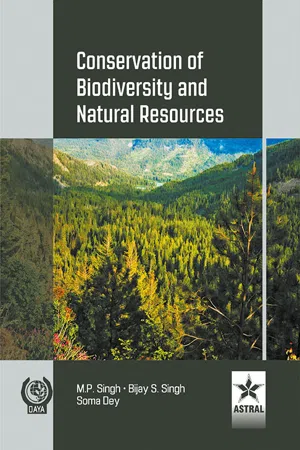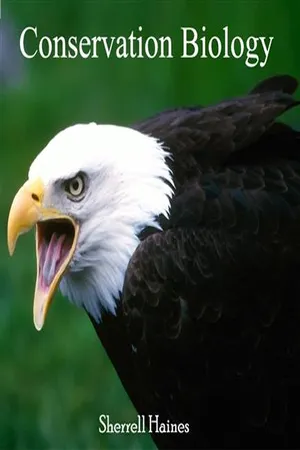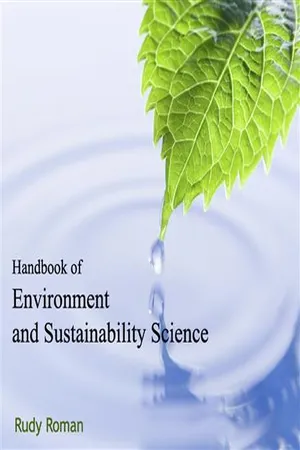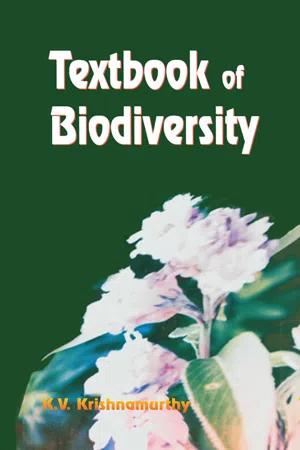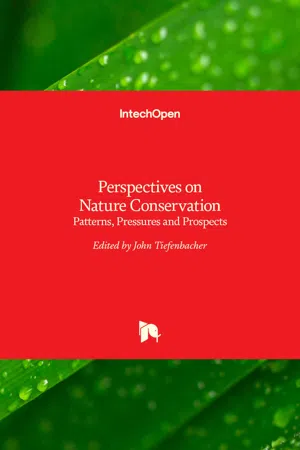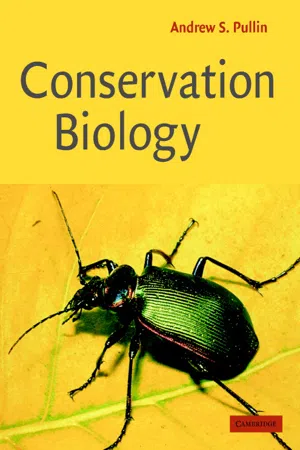Geography
Habitat Conservation
Habitat conservation refers to the protection, preservation, and management of natural environments to safeguard the species that inhabit them. It involves maintaining and restoring ecosystems, such as forests, wetlands, and grasslands, to ensure the survival of diverse plant and animal species. Conservation efforts aim to balance human activities with the needs of wildlife and the environment.
Written by Perlego with AI-assistance
Related key terms
1 of 5
11 Key excerpts on "Habitat Conservation"
- eBook - PDF
Biogeography
Introduction to Space, Time, and Life
- Glen MacDonald(Author)
- 2015(Publication Date)
- Wiley(Publisher)
We have seen that geography and history have worked together to produce the incredibly complex and beautiful modern biosphere that we are a part of. We have also learned that humans have played a lamentable role in the extinction of a great many species. In this final chapter, we have observed that we face many challenges in preserving the remaining biodiversity and natural habitats of the world. Our efforts must take on a spe- cial urgency because as human population grows, the rate of habitat and species loss also increases. The specter of global warming means that no species or environment can be counted on as completely secure in the years ahead. We have seen how the study of biogeography and allied fields can help us to both understand and preserve the natural life of the planet. The application of bio- geography for conservation is still in an early stage, and many exciting discov- eries lie ahead. Perhaps for some of you this book will start you on the road to learning more about biogeography, ecology, paleontology, and the other life and earth sciences. You may actually take up the challenge of working as bio- geographers to understand and protect the biosphere. If so, this book has been more than successful. For others, I will consider this book successful if a trip through a national park or even a simple walk through autumn leaves is just a little more enjoyable because you are now more aware of how you, and all the plants and animals you encounter, are part of the marvelous and continuing story of space, time, and life. - Singh, M P, Soma Dey(Authors)
- 2021(Publication Date)
- Daya Publishing House(Publisher)
5. Habitat between protected areas is more easily traversed by dispersing This ebook is exclusively for this university only. Cannot be resold/distributed. individuals the more closely it resembles suitable habitat for the concerned species. Conservation Targets About one-half of the world’s species may already have been lost (Soule and Sanjayan, 1998). This has prompted the near-term protection of at least 10% of the total land area in each country or in each ecosystem, so as to double or triple the land area now designated as national parks or biosphere reserves. However, protection of only 10% of the Earth’s ecosystems could still make at least one-half of all terrestrial species vulnerable to anthropogenic extinction sooner or later. The situation is particularly serious in the tropics, which contain some two-thirds of the world’s terrestrial plant and animal species. The relatively undisturbed tropical forests (area already reduced by about half during the past five decades of this century) is currently shrinking at a rate of about 0.8% annually. Only 5% of the tropical rainforest biome is protected. The increasing global demand for tropical goods is accelerating rates of habitat conversion in developing nations. It appears that lands outside strictly protected reserves everywhere will be greatly diminished in their capacity to sustain native species and ecosystem by 2050, by which time human population may have more than double (Sole and Sanjayan, 1998). Therefore to deal with this problem a much larger area than 10% (perhaps as much as over 40%), may need to be set aside-aformidable task indeed in light of the fact that even achieving the 10% target in many countries today would be a herculean venture. Some general desirable attributes of conservation measures are outlined below : 1. They must be firmly grounded in the natural sciences, but should also involved the social sciences, humanities, law, education and economics.- eBook - PDF
Protecting Life on Earth
An Introduction to the Science of Conservation
- Michael Paul Marchetti, Peter B. Moyle(Authors)
- 2010(Publication Date)
- University of California Press(Publisher)
140 c ons er vat ion sc i e nce recent years, some conservation practitioners have decided that the establishment of extrac-tive or multi-use reserves is an acceptable com-promise that allows humans and wildlife to coexist. Whatever type of reserve is established, it is best if the reserve is part of a broader sys-tem of protected areas that are under active management. Conservation biologist Michael Rosenzweig argues that natural areas that sup-port biodiversity have to be integrated into the human-dominated landscape because the pro-tected areas are too few and small (even when all added together) to do an adequate job of protecting biodiversity. Thus, one of the big questions around reserve design is, Given lim-ited financial resources, what is the best way to establish a protected area? We will examine this question in detail later in this chapter. COMMUNITY-LEVEL CONSERVATION An alternative to a strictly species-level conserva-tion approach is to focus protection efforts on an entire habitat or community. This approach has some definite advantages. If you protect a community, then you are essentially protecting an entire group of individual species, which is clearly less time-consuming than if you had to work on each species one at a time. In addition, we know from our survey of ecological ideas (Chapters 5 and 6) that individual species do not live in a vacuum; rather, they are linked to hundreds of other species through food webs and other ecological relationships. Therefore, if we truly want to preserve a species, we also need to protect its habitat and community. So why not focus our energies at this level? We will explore what it means to do conservation work with communities by first examining the major complicating factors involved in this kind of enterprise. COMMUNITY-LEVEL COMPLICATIONS There are major challenges facing any scientist working at the community level of ecological organization. - No longer available |Learn more
- (Author)
- 2014(Publication Date)
- Learning Press(Publisher)
________________________ WORLD TECHNOLOGIES ________________________ Chapter-2 Conservation Biology Efforts are being taken to preserve the natural characteristics of Hopetoun Falls, Australia while continuing to allow visitor access Conservation biology is the scientific study of the nature and status of Earth's biodiversity with the aim of protecting species, their habitats, and ecosystems from excessive rates of extinction. It is an interdisciplinary subject drawing on sciences, economics, and the practice of natural resource management. History of term The term conservation biology was introduced as the title of a conference held at the University of California in La Jolla, California in 1978 organized by biologists Bruce Wilcox and Michael Soulé. The meeting was prompted by the concern among scientists ________________________ WORLD TECHNOLOGIES ________________________ over tropical deforestation, disappearing species, eroding genetic diversity within species. The conference and proceedings that resulted sought to bridge a gap existing at the time between theory in ecology and population biology on the one hand and conservation policy and practice on the other. Conservation biology and the concept of biological diversity (biodiversity) emerged together, helping crystallize the modern era of con-servation science and policy. Description The rapid decline of established biological systems around the world means that conservation biology is often referred to as a Discipline with a deadline. Conservation biology is tied closely to ecology in researching the dispersal, migration, demographics, effective population size, inbreeding depression, and minimum population viability of rare or endangered species. Conservation biology is concerned with phenomena that affect the maintenance, loss, and restoration of biodiversity and the science of sustaining evolutionary processes that engender genetic, population, species, and ecosystem diversity. - No longer available |Learn more
- (Author)
- 2014(Publication Date)
- University Publications(Publisher)
________________________ WORLD TECHNOLOGIES ________________________ Chapter- 1 Conservation Biology Efforts are being taken to preserve the natural characteristics of Hopetoun Falls, Australia while continuing to allow visitor access Conservation biology is the scientific study of the nature and status of Earth's biodi-versity with the aim of protecting species, their habitats, and ecosystems from excessive rates of extinction. It is an interdisciplinary subject drawing on sciences, economics, and the practice of natural resource management. History of term The term conservation biology was introduced as the title of a conference held at the University of California in La Jolla, California in 1978 organized by biologists Bruce ________________________ WORLD TECHNOLOGIES ________________________ Wilcox and Michael E. Soulé. The meeting was prompted by the concern among sci-entists over tropical deforestation, disappearing species, eroding genetic diversity within species. The conference and proceedings that resulted sought to bridge a gap existing at the time between theory in ecology and population biology on the one hand and conservation policy and practice on the other. Conservation biology and the concept of biological diversity (biodiversity) emerged together, helping crystallize the modern era of conservation science and policy. Description The rapid decline of established biological systems around the world means that conservation biology is often referred to as a Discipline with a deadline. Conservation biology is tied closely to ecology in researching the dispersal, migration, demographics, effective population size, inbreeding depression, and minimum population viability of rare or endangered species. Conservation biology is concerned with phenomena that affect the maintenance, loss, and restoration of biodiversity and the science of sustaining evolutionary processes that engender genetic, population, species, and ecosystem diversity. - No longer available |Learn more
- (Author)
- 2014(Publication Date)
- University Publications(Publisher)
________________________ WORLD TECHNOLOGIES ________________________ Chapter- 1 Conservation Biology Efforts are being taken to preserve the natural characteristics of Hopetoun Falls, Australia while continuing to allow visitor access Conservation biology is the scientific study of the nature and status of Earth's biodiversity with the aim of protecting species, their habitats, and ecosystems from excessive rates of extinction. It is an interdisciplinary subject drawing on sciences, economics, and the practice of natural resource management. History of term The term conservation biology was introduced as the title of a conference held at the University of California in La Jolla, California in 1978 organized by biologists Bruce ________________________ WORLD TECHNOLOGIES ________________________ Wilcox and Michael E. Soulé. The meeting was prompted by the concern among scientists over tropical deforestation, disappearing species, eroding genetic diversity within species. The conference and proceedings that resulted sought to bridge a gap existing at the time between theory in ecology and population biology on the one hand and conservation policy and practice on the other. Conservation biology and the concept of biological diversity (biodiversity) emerged together, helping crystallize the modern era of conservation science and policy. Description The rapid decline of established biological systems around the world means that conservation biology is often referred to as a Discipline with a deadline. Conservation biology is tied closely to ecology in researching the dispersal, migration, demographics, effective population size, inbreeding depression, and minimum population viability of rare or endangered species. Conservation biology is concerned with phenomena that affect the maintenance, loss, and restoration of biodiversity and the science of sustaining evolutionary processes that engender genetic, population, species, and ecosystem diversity. - eBook - PDF
- K V Krishnamurthy(Author)
- 2003(Publication Date)
- CRC Press(Publisher)
Biodiversity conservationhas thus been changed from an idealistic philosophy to a very serious technology. Conservation biology has also become a very challenging discipline in that it has 'to counter by human forces all that humans themselves have been responsible for'. Current Practice in Conservation Conservation of biodiversity can be attempted at three levels: Genes, Species and Ecosystems. As we have already seen in the first chapter of this book, the three constitute different levels of biological organisation and are interlinked. Maintenance of ecosystem diversity implies conservation of species which constitute that ecosystem, although it is feasible to conserve a species independent of the ecosystem of which it is a normal component. Maintenance of genetic diversity within a species implies maintenance of that species. Conservation of species diversity will take care to some extent of both ecosystem maintenance and genetic maintenance and hence many people consider it pivotal to the conservation of biodiversity. Moreover, loss of species diversity is more obvious and quantifiable than genetic or ecosystem diversity loss. Species in danger of loss can thus be readily identified and suitable conservation strategies planned. Conservation strategies based on species maintenance are labelled 'species-based' approaches. Some people, however, lay emphasis on 'Habitat- or ecosystem-based' approaches for conservation. The relative merits and demerits of either approach are discussed below. o ow ever in very recent years certain biodiversity institutions, such as the Botanic Gardens conservation nternational (BGCI), have instructed Botanic Gardens to give emphasis and priority to the ex-situ mnservation of economically important plants that are threatened (see discussion later in this chapter). Conservation of Genetic Diversity It should be emphasised at the very outset that the unit for genetic conservation is a population of a species, i.e. - Gupta, V K(Authors)
- 2021(Publication Date)
- Daya Publishing House(Publisher)
According to the Convention on Biological Diversity, such an approach remains engaged in establishing ‘a system of protected areas or areas where special measures are need to be taken to conserve biological diversity and develop, where necessary, guidelines for the selection, establishment and management of such areas’ (Convention on Biological Diversity, 2013b). The ex-situ conservation is employed primarily for complementing in-situ measures, and focuses on conserving target species of flora and fauna (and their body representatives like gametes) outside their natural environments and preferably in the country of origin of such components in several ways ( viz . Botanic and Zoological Gardens, Sperm and Ovum Banks, Seed Banks, etc.); and including measures to recover and rehabilitate threatened species and to reintroduce them as well into their natural environment under appropriate conditions (Convention on Biological Diversity, 2013c, Krishnamurthy, 1998). Both these strategies are well applied to Indian scenario to various extents and forms aiming towards (i) prevention of the loss of genetic diversity, (ii) recovering from species loss and prevention of species extinction and (iii) promoting sustainable utilization of natural resources by protecting an ecosystem from existing or prospective threats. The modern concept of conservation thus is briefed as the This ebook is exclusively for this university only. Cannot be resold/distributed. wise maintenance and utilization of the earth’s resources. Table 15.1: Biogeographic Zones of India with Biotic Provinces (after Rodgers and Panwar, 1988) SI. No. Biogeographic Zones Biotic Provinces 1. Trans-Himalayan Ladakh 2. Himalayan North West Himalaya, West Himalaya, Central Himalaya, East Himalaya 3. Desert Kutch, Thar 4. Semi-Arid Punjab, Gujarat-Rajwara 5. Western Ghats Malabar Coast, Western Ghat Mountain 6.- eBook - PDF
Perspectives on Nature Conservation
Patterns, Pressures and Prospects
- John Tiefenbacher(Author)
- 2012(Publication Date)
- IntechOpen(Publisher)
The biodiversity protection seems to be understood as only protecting existing objects. Although greenery is given an important role, it is treated as vague mass. No attention is paid to its quality resulting from its correspondence with local nature. 4.2 Sustainable development According to the Declaration of the UN Conference on Human Habitat (Stockholm 1972), human environment is to be created in cooperation with nature, which implies the necessity of noticing the processes occurring in nature, strengthening their positive manifestations and limiting the negative ones. A similar idea was expressed at the Paris Convention on the Protection of the World Cultural and Natural Heritage of 1972, which discussed the natural areas of value but omitted the significance of the areas transformed by man, e.g. wasteland and its big potential for the free plant succession. The turning point was the Report of The World Commission on Environment and Development of 1987 compiled by Gro Harlem Brundtland, which introduced the definition of sustainable development. Its consequence was the Rio de Janeiro Conference of 1992 and its Agenda 21, which discusses the issue of synergy in the civilisation development, i.e. a full and effective development requires mutual respect of its elements. Nature, meant as greenery and the natural processes, is as important as economy, society and space order. The duration of this system requires the possibility of self-regeneration, which entails allowing the process of natural succession. The aim of the eco-development is to maintain biodiversity and human health, which is included in the European Cities Card for Eco-Development passed in Aalborg in 1994, and also confirmed by the United Nations Millennium Declaration of 2000. One of the main remarks of the Local Agenda 21 of 2002 is the threatening of natural environment by the spreading of invasive - eBook - PDF
- Andrew S. Pullin(Author)
- 2002(Publication Date)
- Cambridge University Press(Publisher)
The former activity attempts to restore a function-ing ecosystem and its component biodiversity, the latter is undertaken for show, to create public interest for short-term political gain. As stated earlier only appropriate monitoring will sort the good scheme from the bad. Habitat creation The creation of new habitats that may be quite different from the origi-nal natural habitat has a questionable role in conservation. Some would argue that this is not conservation at all. Being a human construct, newly created habitat does not have the continuity of form and ‘natu-ralness’ that is normally of high value in conservation. However, the new habitat may have an amenity value and provide new space for valued plants and animals. Is there perhaps also a scientific argument HABITAT CREATION 299 West Penwith Blackdown Hills Dartmoor Somerset Levels and Moors Exmoor South Wessex Downs Test Valley South Downs North Kent Marshes Essex Coast Upper Thames Tributaries Suffolk River Valleys Breckland Broads Shropshire Hills Clun Cotswold Hills South West Peak North Peak Pennine Dales Lake District Fig. 14.6 Location of UK Environmentally Sensitive Areas. for habitat creation? The process certainly suffers from all the draw-backs of habitat restoration and more; there is no evidence that we can create habitat approaching the same diversity as equivalent natural communities, except perhaps in certain circumstances where natural succession quickly takes over, such as in some wetland and aquatic hab-itats. Habitat creation is also rarely documented to the standards required to test a specific hypothesis that would enable us to judge its relative success. Despite this there may be circumstances in which stra-tegic creation of a habitat may be beneficial to species in the surround-ing landscape. A possible example is where communities in small water bodies (ponds and lakes) are threatened due to habitat destruction. - No longer available |Learn more
- (Author)
- 2014(Publication Date)
- The English Press(Publisher)
Systematic conservation planning Systematic conservation planning is an effective way to seek and identify efficient and effective types of reserve design to capture or sustain the highest priority biodiversity values and to work with communities in support of local ecosystems. Margules and Pressey identify six interlinked stages in the systematic planning approach: 1. Compile data on the biodiversity of the planning region 2. Identify conservation goals for the planning region 3. Review existing conservation areas 4. Select additional conservation areas 5. Implement conservation actions 6. Maintain the required values of conservation areas Conservation biologists regularly prepare detailed conservation plans for grant proposals or to effectively coordinate their plan of action and to identify best management practices (e.g.). Systematic strategies generally employ the services of Geographic Information Systems to assist in the decision making process. Conservation biology as a profession The Society for Conservation Biology is a global community of conservation professionals dedicated to advancing the science and practice of conserving biodiversity. Conservation biology as a discipline reaches beyond biology, into subjects such as philosophy, law, economics, humanities, arts, anthropology, and education. Within biology, conservation genetics and evolution are immense fields unto themselves, but these disciplines are of prime importance to the practice and profession of conservation biology. [...] there are advocates and there are sloppy or dishonest scientists, and these groups differ. Chan Is conservation biology an objective science when biologists advocate for an inherent value in nature? Do conservationists introduce bias when they support policies using qualitative description, such as habitat degradation , or healthy ecosystems? As all scientists hold values, so do conservation biologists.
Index pages curate the most relevant extracts from our library of academic textbooks. They’ve been created using an in-house natural language model (NLM), each adding context and meaning to key research topics.

